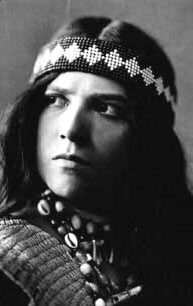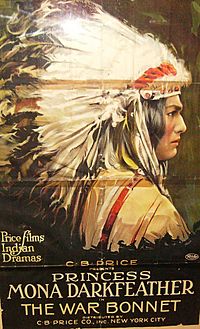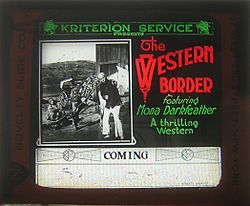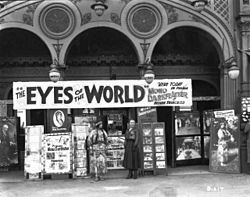Mona Darkfeather facts for kids
Josephine M. Workman, known by her stage name Princess Mona Darkfeather, was an American actress. She was born on January 13, 1882, and passed away on September 3, 1977. Mona Darkfeather became famous for her roles in movies about Native Americans and in Western films.
During the time of silent movies, from 1911 to 1917, she acted in 102 films. She is especially remembered for playing Prairie Flower in the 1914 movie The Vanishing Tribe. Her acting journey began in 1909. She saw an advertisement in a local newspaper from producer and director Thomas H. Ince's Bison Motion Pictures.
At that time, it was rare for movie studios to hire Native American actors. Bison Motion Pictures was looking for an actress who looked like an American Indian. They also needed someone who could do stunts and ride horses well. Even though Josephine Workman had never acted before, she looked just like what Ince wanted. She wasn't a great rider at first, but she quickly became very good at it. She was given the stage name Mona Darkfeather, and later "Princess" Mona Darkfeather. Her first main role was as an Indian maiden named Owanee in the 1911 movie Owanee's Great Love.
| Top - 0-9 A B C D E F G H I J K L M N O P Q R S T U V W X Y Z |
Early life and family
Mona Darkfeather was born as Josephine M. Workman in Boyle Heights, California. She was baptized in Los Angeles when she was four months old. Her parents were Joseph Manuel Workman (1833–1901) and Josephine Mary Belt (1851–1937). She had several brothers and sisters.
Her grandparents were William Workman (1799-1876) from England, and Nicolasa Urioste (1802-1892) from the Taos Pueblo in New Mexico. According to the Workman and Temple Family Homestead Museum, her grandmother Nicolasa was of Taos Pueblo heritage. Her mother had Scottish and Chilean roots. Mona Darkfeather also said she had Spanish ancestors. She was part of the well-known Workman family of Los Angeles.
Married life
Mona Darkfeather first married Harry Martin Knoll in 1906, but he passed away in 1908. Later, in 1912, she married film director and actor Frank E. Montgomery (born Frank Akley; 1870–1944). In 1914, Frank Montgomery moved to Spokane, Washington. There, he started a school for acting in movies, and Mona Darkfeather helped as an instructor.
Mona Darkfeather and Frank Montgomery divorced in 1928. In the same year, she married Alfred Wessling, a banker. They divorced in 1935. However, on December 23, 1937, Mona Darkfeather and Frank Montgomery remarried. They stayed together until Frank's death in 1944.
Becoming a movie star
After answering a newspaper ad in 1909, Mona Darkfeather quickly became famous. The ad was from Bison Motion Pictures and asked for "exotic-looking girls" to play "Indian maidens." She was known for jumping onto her pinto pony, named "Comanche," and riding away bareback.
Mona Darkfeather was a well-known movie artist. She often played roles as Indian women and in Western dramas. Even though she was mostly of European and Chilean descent, her early publicity said she was a full-blooded Blackfoot Indian. She even claimed to be an Indian Princess. She said a "Chief Big Thunder" made her a blood member of the Blackfoot Nation and gave her the title of princess.
She acted in short Western melodrama films, like A White Indian (1912) and A Blackfoot's Conspiracy (1912). She also starred in longer feature length movies. She became a major movie star. She also played main roles as Spanish women in several historical dramas.
Darkfeather often appeared in films directed by her husband, Frank Montgomery. They worked for different movie companies, including Bison Company, Universal, Kalem Company, and Sawyer Inc. Under Frank Montgomery's guidance, Mona Darkfeather played Indian and Spanish leading roles in many Bison Company films. She made movies for Bison starting in 1909, for the Selig Polyscope Company between 1909 and 1913, for Nestor Studios in 1912, and for Kalem Studios starting in 1913.
Montgomery directed her in the 1912 film The Massacre of the Fourth Cavalry. Other films he directed her in include A Forest Romance, For the Peace of Bear Valley, and Justice of the Wild, all released in 1913. In these films, she acted alongside Harry von Meter.
Mona Darkfeather was the first choice for director Cecil B. DeMille to play the Indian wife, Nat-u-ritch, in his famous Western movie The Squaw Man (1914). However, she was too busy. She and Montgomery were making their own movies independently for Kalem Company, so she could not take the role.
In 1914, she and Montgomery joined the Universal Film Company. They continued to work together on many Western films. Mona Darkfeather's last movie was The Hidden Danger in 1917. After that, she retired from acting in films.
For some time after retiring from movies, she performed on the stage. She was a headliner as Princess Darkfeather. In August 1918, she made a special appearance at the Liberty Theater in Tacoma, Washington. She acted, sang, and gave talks. She appeared after each showing of the movie Eyes of the World (1917) to sing and offer advice to girls who wanted to enter show business.
Later life
In January 1921, Mona Darkfeather won a lawsuit in Los Angeles. This lawsuit was about land that her father had sold in 1895. The court decided she had a share in the land. However, this decision was later changed by the Supreme Court in September 1922.
Mona Darkfeather and Frank Montgomery divorced in 1928. She then married Alfred G. Wessling (1869–1941), a wealthy banker, in 1928. They lived in Monrovia in 1930 and in Hermosa Beach in 1934.
She and Wessling divorced in 1935. On December 23, 1937, she and Frank Montgomery remarried. At that time, Frank was a technician in the sound department at Hal Roach Studios. They stayed married until his death in 1944.
Mona Darkfeather passed away at age 94 from a stroke in Los Angeles. She is buried in the Holy Cross Cemetery in Culver City, California, under her birth name, Josephine Workman.
Images for kids
See also
 In Spanish: Mona Darkfeather para niños
In Spanish: Mona Darkfeather para niños






